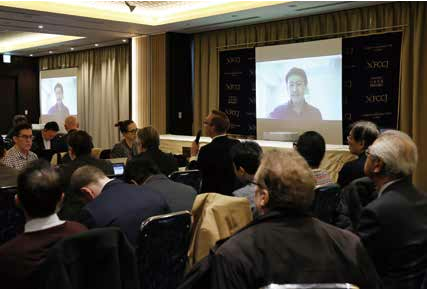Issue:

THE DEEPENING CRISIS OVER the over COVID-19 outbreak including its inexorable spread around the world and the apparent inability of health authorities to get to grips with the problem has dominated the news cycle since early January and, as of the time of writing, shows no sign of slowing down.
And while the vast majority of infections and fatalities are still in China, Japan found itself very much in the spotlight after the virus was confirmed among a handful of the 3,700 passengers and crew aboard the cruise ship the Diamond Princess.
In order to help journalists grasp the situation and learn about the virus, the Foreign Correspondents’ Club of Japan hosted three press conferences with medical professionals in February, with comments by each of the professors sufficient bombshells to grab the global headlines.
Hiroshi Nishiura, a professor in Hokkaido University’s Graduate School of Medicine, spoke at the FCCJ on Feb. 4 relatively early in the crisis, when there were fewer than 10,000 confirmed cases and around 200 deaths. His message, however, was far from optimistic and he warned that simply isolating people who had recently traveled to China might not be sufficient to stop the spread of the virus in its tracks. Three weeks later, it is clear that prediction was on the mark.
“WE MAY FIND THAT containment is not feasible,” said Nishiura, who heads a team set up quickly at the university to study the path of the virus. “Countries may have to switch from containment to mitigation.” Part of the problem, he said, is that it was already becoming apparent that people with no symptoms of the illness but who had been infected were passing it on to those they came into close contact with.
Nishiura’s studies indicated that risk of death in confirmed cases at the time was between 3 percent and 6 percent, but that as many as half may not have any symptoms of being infected and may not even become sufficiently unwell to require hospital treatment. He did warn, however, that the peak of the disease may not come until April and called on health authorities to prepare more hospital beds and ventilators for people who develop pneumonia.
Fifteen days later, concern around the illness had become significantly more acute and Hitoshi Oshitani, a professor of virology in Tohoku University’s Graduate School of Medicine, set the cat among the Olympic pigeons by suggesting that the upcoming summer Games are under threat from the rapidly spreading virus. “We need to find the best way to have a safe Olympics,” he said. “Right now, we don’t have an effective strategy and I think it may be difficult to have the Olympics. But by the end of July, we may be in a different situation.”
The organizers of the Tokyo games, the Japanese government and the Tokyo Metropolitan Government had then all been at pains to reassure the world that the city will be completely ready for the occasion by the time the opening ceremony takes place on July 24.
Oshitani, who previously served as an adviser to the World Health Organization and helped combat the outbreak of SARS in 2003, said his greatest concern was a “Wuhan-type” outbreak elsewhere in Asia or Africa that would lead to more cases coming into Japan. In that scenario, he said, “It may be difficult to have” the Olympics in Tokyo.
“What we have to do is try to prevent such a thing from happening,” Oshitani said. “Nobody can predict whether we can contain the virus or put an end to this outbreak before the Olympics starts that’s anybody’s guess.”
PERHAPS THE BIGGEST BOMBSHELL came from Kentaro Iwata, a professor of infectious diseases at Kobe University, who was only able to address members of the club through a video link as he had voluntarily placed himself in quarantine after going aboard the Diamond Princess where he had previously described infection control efforts as shambolic.
On Feb. 19, Iwata uploaded two YouTube videos, in Japanese and English, which quickly attracted attention for his first-hand account of what he saw on a visit to the vessel. He said the situation on the ship was “chaotic,” with bureaucrats in charge instead of experts in viral diseases. He added that there was no distinction between “red,” or infected areas, and “green” zones that were free of the virus.
The day of the FCCJ press conference, Iwata took the videos off the site, saying the situation aboard the cruise ship had improved. “The post became so viral and viewed by many people and yesterday I was informed that significant improvement was done inside the cruise ship,” he said. Iwata denied that he had been pressured by the government to remove the clips as they were so critical of the response to the situation on board.
Iwata insisted that the YouTube clips had achieved their aim, including emphasizing that bureaucrats have no experience in how to prevent infections from spreading. “We have to be prepared,” he added. “We have to be extremely cautious, but we should not panic. That is my opinion.”
Julian Ryall is the Japan correspondent for the Daily Telegraph.

